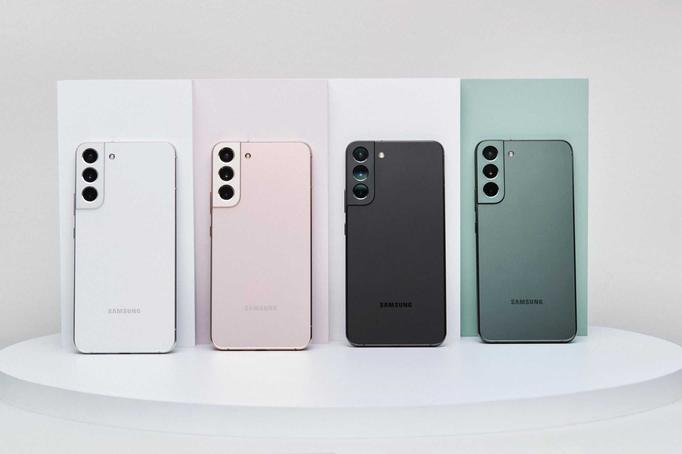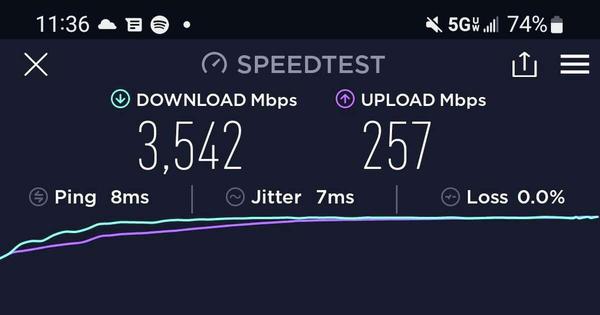
Verizon gets a 5G speed bump with new C-band spectrum — if you can find it
With the launch last month of Verizon’s latest Galaxy S22 smartphones, the universe of C-band-capable phones has expanded. Two handsets I was sent for review, the S22+ and the S22 Ultra, are both C-band compatible. And the S22+ model is set up to work on Verizon’s network. Last week, I reviewed the Ultra, and much of what I said about that phone — which is really a Galaxy Note in Galaxy S clothing — applies to the S22+. The latter is smaller, with no S-Pen stylus and only one telephoto camera. It’s also a lot cheaper, starting at $999.
This week, I want to focus on the Verizon C-band angle of the S22+. Does this new frequency let Verizon catch up to T-Mobile, whose 5G service has been running circles around both Verizon and AT&T? T-Mobile got access to a different - but still zippy - mid-band spectrum in its acquisition of Sprint, and has been using those airwaves to its advantage.
First, some background about 5G and how the three major U.S. carriers have deployed it.
As I’ve written in the past, 5G has three distinct “layers” of wireless frequencies.
Both AT&T and Verizon cast their initial lot with mmWave. They also launched a sub-6 flavor of 5G, but it was in some cases slower than 4G. The two spent tens of billions of dollars on an auction that ended in 2021 for C-band spectrum, which bridges the high- and low-frequency services.
(AT&T is in the same boat as Verizon, hoping that C-band will give it a competitive boost. But it’s been more conservative about its rollout, with Houston only one of eight cities getting it. I don’t have a C-band-capable AT&T phone yet; I’ll look at their implementation in a future column.)
Houston is one of the cities where Verizon has fired up its C-band service; the carrier says it’s available to more than 100 million people across the country. Houston is a unique market for Verizon, because it has been aggressive in expanding the footprint here of mmWave. Ours was the first city in which Verizon stood up its 5G Home service, which wirelessly competes with broadband providers like Comcast and AT&T. Verizon has leveraged that expansion for its mobile service.
Location, location, location
Based on the testing I’ve done since receiving the S22+ in early February, if you have a C-band-capable Verizon phone you will see a noticeable improvement in 5G speeds - if you are in the right location. However, if you’re getting speeds much better than its sub-6 5G service, or even 4G LTE, you won’t see anything on the device indicating whether you’re using C-band or mmWave.

That’s because, as a Verizon spokesperson told me, the company wants to tag both faster categories of 5G as “Ultrawideband,” the moniker it has been using for mmWave. When connected to either C-band or mmWave, you’ll see a top-of-screen “5G UW” icon. She said 4G LTE is a collection of different frequencies which aren’t broken out, and that’s also how Verizon wants to frame its 5G service.
You will, however, be able to tell the difference based on where you are and the actual speed you’re seeing.
In driving around Houston, I’ve clocked speeds as fast 3.5 gigabits per second. For comparison, that’s more than three times as fast as Comcast’s and AT&T’s 1-Gbps, top-speed, home-internet offering. That’s a mmWave speed test result, and I got it sitting in the parking lot at the Kroger at West Gray and Woodhead. It’s exceptional; speeds of 2 Gbps to 2.5 Gbps are more typical of mmWave.
Upload speeds with mmWave varied greatly, from as low as 14 Mbps to as fast as 257 Mbps.
But you usually see that outside, at intersections or in neighborhoods where Verizon has expanded its service. You won’t see it, however, sitting inside a home in those neighborhoods, or inside that Kroger, because mmWave can’t pass through walls. (And exactly what you’d do with a 3.5-Gbps download speed in a grocery store parking lot is, for now, a mystery.)
C-band is also impressive but much slower than mmWave. It’s closer to fast home-broadband speeds between 700 Mbps to a little over 1 Gbps. It slows somewhat indoors, closer to 300 Mbps to 500 Mbps, according to Verizon, depending on the location and how far inside a building you are. Upload speeds were disappointing, usually in the single to mid-teens in Mbps.
But Verizon’s C-band is relatively hard to find. I came across it occasionally in travels around town, but it’s definitely a work in progress. Verizon’s coverage map for Houston shows a big chunk of it east of downtown, but the spokesperson I talked to wouldn’t go into detail on the strategy of its early deployment locations. Expect that area to grow as the year goes on.
One of the issues with 5G on Verizon and AT&T is that early adopters who bought 5G smartphones have devices that can’t take advantage of these new, mid-band frequencies. They’re stuck with pokey sub-6 connections, or stumbling across a mmWave tower. Besides the new Galaxy S22 line, C-band capable phones include last year’s S21 devices; Samsung’s Galaxy Z Fold 3 and Z Flip 3 phones; the Galaxy A13; Apple’s iPhone 12 and 13 lines. The Google Pixel 6 and 6 Pro work on AT&T’s C-band, and a software update is coming that will enable it on Verizon’s.
Speed envy
This begs the question: If you bought 5G hardware early, is it worth replacing a phone sooner than you normally might to get these speeds?
If you’re a Verizon customer whose day-to-day smartphone use would be helped by faster speeds, then I’d say yes. As a T-Mobile user with a mid-band-capable iPhone 13 Pro Max, I can tell you that the experience is excellent. I get mid-band speeds between 300 Mbps and 700 Mbps when out and about, and the spots where I’m seeing that performance are more numerous every week.
Verizon and AT&T customers no longer need to suffer speed envy, with the right phone.
dsilverman@outlook.com
twitter.com/dsilverman
}})